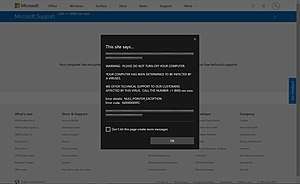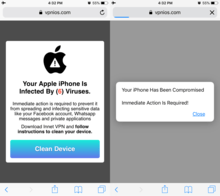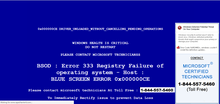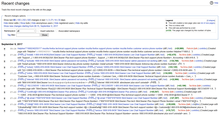Technical support scam
A technical support scam refers to any class of telephone fraud activities in which a scammer claims to offer a legitimate technical support service, often via cold calls to unsuspecting users. Such calls are mostly targeted at Microsoft Windows users, with the caller often claiming to represent a Microsoft technical support department.


In English-speaking countries such as the United States, Canada, United Kingdom, Ireland, Australia and New Zealand, such cold call scams have occurred as early as 2008.[1]
The scammer will typically attempt to get the victim to allow remote access to their computer. After remote access is gained, the scammer relies on confidence tricks, typically involving utilities built into Windows and other software, in order to gain the victim's trust to pay for the supposed "support" services. The scammer will often then steal the victim's credit card account information or persuade the victim to log into their online banking account to receive a promised refund, only to steal more money, claiming that a secure server is connected and that the scammer cannot see the details. Many schemes involve convincing the victim to purchase expensive gift cards and then to divulge the card information to the scammer.[2]
Operation

Technical support scams typically rely on social engineering. Scammers use a variety of confidence tricks to persuade the victim to install remote desktop software (often by informing the victim that the scammer is connecting the computer to a "secure server"), with which the scammer can then take control of the victim's computer. With this access, the scammer may then launch various Windows components and utilities (such as the Event Viewer), install third-party utilities (such as rogue security software) and perform other tasks in an effort to convince the victim that the computer has critical problems that must be remediated, such as infection with a virus. The scammer will urge the victim to pay, with a credit card or gift card, so the issues may be "fixed".[1][3][4]
Initiation

Technical support scams can begin in a variety of ways.[3][5] A scam most commonly begins with a cold call, usually claiming to be associated with a legitimate-sounding third party, with a name like "Microsoft", "Windows Technical Support" or "HP Support" .[6] Scammers have also lured victims by purchasing keyword advertising on major search engines (with ads triggered by phrases such as "Microsoft live chat", "Facebook support", or "Outlook login help"), though both Bing and Google have taken steps to restrict such schemes. Other techniques include email spamming and cybersquatting to lead potential victims to web pages containing scammers' phone numbers.[7][8] Some scams have been initiated via pop-up ads on infected websites instructing the potential victim to call a number. These pop-ups often closely resemble legitimate error messages such as the Blue Screen of Death.[9][10]
Remote access
While normally following a script, the scammer usually instructs the victim to download and install a remote access program, such as TeamViewer, AnyDesk, LogMeIn, GoToAssist,[11] etc. With the software installed, the scammer convinces the victim to provide them with the remote access software's credentials or other details required to initiate a remote-control session, giving the scammer complete control of the victim's desktop.[1][12]
Confidence tricks
After gaining access, the scammer attempts to convince the victim that the computer is suffering from problems that must be repaired, most often as the putative result of malicious hacking activity. Scammers use several methods to misrepresent the content and significance of common Windows tools and system directories as evidence of malicious activity, such as viruses and other malware. Normally the elderly and other vulnerable parties, such as those with limited technical knowledge, are targeted for technical support scams.
- The scammer may direct users to Windows' Event Viewer, which displays a logfile of various events for use by system administrators and expert users to troubleshoot problems. Although many of the log entries are relatively harmless notifications, the scammer may fraudulently claim that log entries labeled as warnings and errors are evidence of malware activity or that the computer is becoming corrupted, and that the errors must be "fixed".[3][5][13]
- The scammer may present system folders that contain unusually named files, such as Windows' Prefetch and Temp folders, and claim that the files are evidence of malware on the system. The scammer may open some of these files (especially those in the Prefetch folder) in Notepad, where the file contents are rendered as mojibake. The scammer claims that malware has corrupted these files, causing the unintelligible output. In reality, the files in Prefetch are typically harmless, intact binary files used to speed up certain operations.[13]
- The scammer may misuse Command Prompt tools to generate suspicious-looking output, for instance, the
treeordir /scommand, which displays an extensive listing of files and directories. The scammer may claim that the utility is a malware scanner, and while the tool is running, the scammer will enter text purporting to be an error message (such as "security breach ... trojans found") that will appear when the job finishes, or into a blank Notepad document.[14] - The scammer may misrepresent values and keys stored in the Windows Registry as being malicious, such as innocuous keys whose values are listed as not being set.[3]
- The "Send To" Windows function is associated with a globally unique identifier. The output of the command
assoc, which lists all file associations on the system, displays this association with the lineZFSendToTarget=CLSID\{888DCA60-FC0A-11CF-8F0F-00C04FD7D062}; this GUID is the same on all versions of Windows. The scammer may claim that this is a unique ID used to identify the user's computer, or claim that the CLSID listed is actually a "Computer Licence Security ID" that must be renewed.[15][16] - The scammer may claim that the system's problems are the result of expired hardware or software warranties, for example, Windows product keys, and coax the victim into paying for a "renewal".[5][13]
- The scammer may run the obscure
syskeyutility and configure a startup password known only to the scammer, thereby locking the victim out of their own system after the computer is rebooted.[17][18] Assyskeyis only present in Windows versions previous to Windows 10, the scammer may force the user to become locked out by installing a keylogger and changing the user's account password and/or setting a PIN login requirement if the victim's computer runs on Windows 10.[19] - The scammer may delete Windows critical files and folders such as
system32, making the computer unusable until the operating system has been reinstalled. - The scammer may use their remote access software to surreptitiously download or delete confidential files or documents from the victim’s system while employing distraction techniques or while the victim is away from the computer procuring payment.
- The scammer may block the victim from viewing their screen, claiming that it is the result of malware or of a scan being run, and use the time to search the user's files for sensitive information, attempt to break into the user's accounts with stolen or stored credentials or activate the webcam and see the user's face.[19]
- The scammer may run the
netstatcommand in a terminal/command window, which shows local and foreign IP addresses. The scammer then tells the victim that these addresses belong to hackers that have intruded the computer. - The scammer may claim that a normal Windows process such as
rundll32.exeis a virus. Often, the scammer will search the web for an article about the Windows process and will scroll to a section saying that the process name can also possibly be part of malware, even though the victim's computer does not contain that malware.
Objectives
These tricks are meant to target victims who may be unfamiliar with the actual uses of these tools, such as inexperienced users and senior citizens—especially when the scam is initiated by a cold call.[1][6][20] The scammer then coaxes the victim into paying for the scammer's services or software, which they claim is designed to "repair" or "clean" the computer but is actually malware that infects it or software that causes other damage, or does nothing at all.[21] The scammer may gain access to the victim's credit card information, which can be used to make additional fraudulent charges. Afterward, the scammer may also claim that the victim is eligible for a refund, and request the user's bank account information—which is instead used to steal more money from the victim, rather than providing the promised refund.[3][5][6][13][22][23] Alternatively, a scammer may attempt to request payment using gift cards for online platforms such as Amazon.com, Google Play, and iTunes Store.[24][25]
Some technical support scammers may surreptitiously open the victim's webcam in order to see what their victim looks like. They may also configure TeamViewer or other remote access clients for unattended access to the user's computer, so that they may return later and try to harass or intimidate a victim.
Unlike legitimate companies, if their targets show resistance or refuse to follow the scammer or pay them, the scammer may become belligerent and insult, threaten[26][27] or even blackmail the user into paying them. Canadian citizen Jakob Dulisse reported to CBC that, upon asking the scammer why he had been targeted, the scammer responded with a death threat; 'Anglo people who travel to the country India were "cut up in little pieces" and thrown in the river.'[28][29]
In an investigation conducted by Symantec employee Orla Cox, it was revealed that after Cox paid for the fee for the scammer to remove the nonexistent "malware" infections, the scammers would then merely clear the log in the Event Viewer and disable Windows' event logging feature. This merely means that errors would no longer appear in the Event Viewer, i.e. had malware actually existed on Cox's computer, it would remain intact.[30]
Unethical and fake "support" companies
The great majority of the complaints and discussion about companies that cold-call and offer "technical support"[31] report them as being not merely incompetent or ineffective, but actively dishonest, doggedly trying to convince the victim of non-existent problems by trickery and, when possible, damaging the computer to which they gain access.[3][32][33] Computer-support companies advertise on search engines like Google and Bing,[31][34] but some are heavily criticised, sometimes for practices similar to those of the cold callers. One example is the India-based company iYogi, which has been reported by InfoWorld to use scare tactics and install undesirable software.[35][36] In December 2015, the state of Washington sued iYogi's US operations for scamming consumers and making false claims in order to scare the users into buying iYogi's diagnostic software.[37] iYogi, which was required to respond formally by the end of March 2016,[38] said before its response that the lawsuit filed was without merit.[39] In September 2011, Microsoft dropped Comantra, a Gold Partner, from its Microsoft Partner Network following accusations of involvement in cold-call technical-support scams.[40]
In December 2014, Microsoft filed a lawsuit against a California-based company operating such scams for "misusing Microsoft's name and trademarks" and "creating security issues for victims by gaining access to their computers and installing malicious software, including a password grabber that could provide access to personal and financial information".[41] In an effort to protect consumers, Microsoft-owned advertising network Bing Ads (which services ad sales on Bing and Yahoo! Search engines)[42][43] amended its terms of service in May 2016 to prohibit the advertising of third-party technical support services or ads claiming to "provide a service that can only be provided by the actual owner of the products or service advertised".[7][44] Google Search followed suit in August 2018, but went further by banning any advertising related to technical support, regardless of source, citing that it had become too difficult to differentiate legitimate providers from scams.[45]
Scams from India
Due to being part of the British Empire, India has millions of English speakers who are competing for few jobs. One municipality had 114 jobs and received 19000 applicants, and it is not uncommon for these unemployed youth to riot. [46] Tech scamming jobs then become very attractive as it provides a lucrative opportunity. Many scammers do not realize they are applying for tech scam jobs, but many often stay and continue to scam people even after they realize what they are doing. When one tech scammer was asked why she continues to work for scammers she replied “You think because the people who run these call centres are making so much money every day, you might as well make some of it while you are here,” [47]. When the BBC interviewed another tech scammer in India and asked why he scams people he replied "It was easy money," and then went on to detail how he bought fancy cars and wore designer clothes.[48] Scammers in India often convince themselves that they are targeting wealthy people in the west and that it is okay to take money from them since they have so much.[49] In March 2020 the BBC published a joint string operation between them and famed scam baiter Jim Browning where they managed to get access to a scam call center located in the Gurugram suburb of Delhi. Jim Browning managed to hack the security cameras of the scam call center and recorded the internal functions of the center including the owner, Amit Chauhan, having a meeting talking about their scams. [50]
Scam baiting
Tech support scammers are regularly targeted by scam baiting[51] both online and offline, with individuals seeking to raise awareness of these scams by uploading recordings on platforms like YouTube, cause inconvenience to the scammers by wasting their time, and by disabling the scammer's computer systems by deploying RATs, distributed denial of service attacks and destructive computer viruses. Scam baiters may also attempt to lure scammers into exposing their unethical practices by leaving dummy files or malware disguised as confidential information, such as credit/debit card information and passwords, on a virtual machine for the scammer to attempt to steal, only to himself or herself become infected.
In November 2017, a company called Myphonesupport initiated a petition seeking the identities of John Doe defendants in a New York case involving a telephonic denial-of-service attack against its call centers. The case has since been disposed.[52]
In March 2020, an anonymous YouTuber under the alias "Jim Browning" successfully infiltrated and gathered drone and CCTV footage of a fraudulent call centre scam operation through the help of fellow YouTube personality Karl Rock. Through the aid of the British documentary programme Panorama, a police raid was carried out when the documentary was brought to the attention of assistant police commissioner Karan Goel,[53] leading to the arrest of call centre operator Amit Chauhan who also operated a fraudulent travel agency under the name "Faremart Travels".
Kitboga is an American scambaiter who regularly streams videos on Twitch and uploads highlights on YouTube. He began baiting in mid-2017 after he found out that his grandmother was a victim of many types of scams designed to prey on the elderly, both online and in-person. To misdirect scammers away from his real identity, as well as for viewer entertainment, Kitboga often acts as a number of characters during his videos, including an 80-year-old grandmother named Edna,[54] a valley girl named Nevaeh,[55] or sometimes even a competing technical support scammer named Daniel. In his videos, Kitboga engages in scambaiting several types of scammers, a majority of whom operate call centers in India. Besides technical support scammers, he also engages with refund scammers, IRS scammers, and others.
See also
- Cybercrime in India
- List of confidence tricks
- Telemarketing fraud
- Virus hoax
- Rogue anti-virus
References
- Arthur, Charles (18 July 2012). "Virus phone scam being run from call centres in India". Guardian. Archived from the original on 28 March 2014. Retrieved 31 March 2014.
- Weiss, Gary. "How Scammers Use Gift Cards to Steal Your Money". AARP. Retrieved 2019-08-01.
- Segura, Jérôme. "Tech Support Scams - Help & Resource Page | Malwarebytes Unpacked". Malwarebytes Corporation. Archived from the original on 28 March 2014. Retrieved 28 March 2014.
- Weiss, Gary. "How Scammers Use Gift Cards to Steal Your Money". AARP. Retrieved 2019-08-01.
- Hunt, Troy (February 21, 2012). "Scamming the scammers – catching the virus call centre scammers red-handed". Archived from the original on 7 April 2014. Retrieved 1 April 2014.
- "Hello, I'm definitely not calling from India. Can I take control of your PC?". Ars Technica. Archived from the original on 21 November 2014. Retrieved 16 November 2014.
- "Microsoft to Bing users: No more shady third-party ads for tech support, password recovery". ZDNet. Archived from the original on 14 May 2016. Retrieved 13 May 2016.
- "Despite Crackdowns, Tech Support Ads In Search Are Still Cause For Consumer Confusion" Archived 2015-03-28 at the Wayback Machine. Search Engine Land, Ginny Marvin on August 5, 2014
- Harley, David (7 October 2015). "Tech Support Scams: Top of the Pop-Ups". WeLiveSecurity. Archived from the original on 27 July 2016. Retrieved 28 July 2016.
- "Do not respond to scam pop-up messages in your web browser". www.communications.gov.au. Department of Communications and the Arts. Archived from the original on 2016-04-20. Retrieved 2016-04-19.
- Brodkin, Jon (25 November 2013). "Fake tech support scam is trouble for legitimate remote help company". Ars Technica.
- Technical support scammers (8 July 2017). "Fake ConnectWise Control login purporting to be British Telecom technical department (note name of site)". bttechnicaldepartment.screenconnect.com. Archived from the original on 8 July 2017.
- Solon, Olivia (11 April 2013). "What happens if you play along with a Microsoft 'tech support' scam?". Wired.co.uk. Archived from the original on 7 November 2014. Retrieved 10 November 2014.
- Lodhi, Nauman. "Beware of Microsoft Tech Support Scammers". Business 2 Community. Archived from the original on 19 April 2014. Retrieved 18 April 2014.
- "Support desk scams: CLSID not unique". WeLiveSecurity. ESET. Archived from the original on 23 October 2014. Retrieved 15 November 2014.
- "Support-Scammer Tricks". WeLiveSecurity. ESET. Archived from the original on 25 December 2014. Retrieved 15 November 2014.
- Woodchip computers:Have you been caught by the "I am Windows Support" scam? Archived 2014-11-08 at the Wayback Machine
- Holzman, Carey (14 November 2014). "'Microsoft Partner' Claims Fuel Support Scams". Kerbs on Security. Archived from the original on 25 September 2016. Retrieved 26 July 2016.
- Jim Browning (2018-08-04), This is why you never let anyone remotely access your computer, retrieved 2018-09-09
- "Microsoft Phone Scams". www.which.co.uk/. Which?. Archived from the original on 2015-02-13.
- Graham Scott, Gini (2016). Scammed: Learn from the Biggest Consumer and Money Frauds How Not to Be a Victim. Allworth Press. p. 182. ISBN 978-1-62153-504-1.
- "Tech Support Scams". Federal Trade Commission. Archived from the original on 31 October 2014. Retrieved 16 November 2014.
- Winterford, Brett (May 18, 2011). "How the Microsoft/LogMeIn support scam works". ITnews.com.au. Archived from the original on 7 April 2014. Retrieved 1 April 2014.
- "No gift cards for tech support scammers". Consumer Information. FTC. 2018-06-06. Retrieved 2018-08-22.
- ""From laughter to death threats": Meet Kitboga, the streamer exposing tech support scams". Newsweek. 2018-05-22. Retrieved 2018-08-22.
- Melendez, Steven (2019-05-10). "The awful, fast-growing tech scams fleecing the elderly out of millions". Fast Company. Retrieved 2019-11-15.
- "Kitboga: The Internet star giving scammers a taste of their own medicine | CTV News". www.ctvnews.ca. Retrieved 2019-11-15.
- "Death threat issued in bogus tech support call". BBC News. Retrieved 24 October 2019.
- Brodkin, Jon (2015-03-04). "Tech support scammer threatened to kill man when scam call backfired". Ars Technica. Retrieved 2019-11-15.
- Cox, Orla (22 June 2010). "Technical Support Phone Scams". Symantec. Archived from the original on 19 August 2016. Retrieved 3 August 2016.
- Hunt, Troy. "Interview with the man behind Comantra, the "cold call virus scammers"". Archived from the original on 16 April 2014. Retrieved 18 April 2014.
- Baker, Steve. "What Seniors (And Their Children) Need To Know About Tech Support Scams". Forbes. Archived from the original on 20 April 2017. Retrieved 19 April 2017.
- "Reputation of guruaid.com". WOT. Archived from the original on 2014-05-02.
- "How iYogi & Guruaid running tech support campaigns?". AdWords Community. Retrieved 2 May 2014.
- Cringley, Robert (28 March 2012). "The downward (dog) spiral: iYogi exposed". InfoWorld. Archived from the original on 7 April 2014. Retrieved 3 April 2014.
- Cringley, Robert (21 March 2012). "Tech support or extortion? You be the judge". InfoWorld. Archived from the original on 29 May 2015. Retrieved 9 June 2015.
- Washington state sues firm, alleges tech support scam Archived 2015-12-21 at the Wayback Machine, Associated Press, 16 December 2015
- Joe Panettieri (18 March 2016). "iYogi IT Services Lawsuit: State of Washington Awaits Response - ChannelE2E". ChannelE2E. Archived from the original on 29 March 2016. Retrieved 24 March 2016.
- Lawsuits Cloud iYogi Remote Tech Support Reputation Archived 2016-03-09 at the Wayback Machine, 11 Jan 2016
- Microsoft Drops partner accused of Cold-Call Scams Archived 2016-06-30 at the Wayback Machine, 22 February 2016
- Whitney, Lance (19 December 2014). "Microsoft combats tech support scammers with lawsuit". CNET. Archived from the original on 21 December 2014. Retrieved 21 December 2014.
- "Microsoft loses exclusivity in shaken up Yahoo search deal". Ars Technica. Archived from the original on 23 June 2015. Retrieved 30 June 2015.
- "Ad Tech And Mobile In Focus In Microsoft And Yahoo's Renewed Search Deal". TechCrunch. Archived from the original on 26 June 2015. Retrieved 30 June 2015.
- "Bing bans tech support ads—because they're mostly scams". Ars Technica. Archived from the original on 13 May 2016. Retrieved 13 May 2016.
- "Google to nix all tech support provider ads". iTnews. Retrieved 2018-09-03.
- https://www.theguardian.com/news/2018/jan/02/the-scammers-gaming-indias-overcrowded-job-market
- https://www.theguardian.com/news/2018/jan/02/the-scammers-gaming-indias-overcrowded-job-market
- https://www.bbc.com/news/stories-51753362
- https://www.bbc.com/news/stories-51753362
- https://www.bbc.com/news/stories-51753362
- "A guide to trolling a tech support scammer". WIRED UK. Retrieved 3 October 2018.
- "Consumer Software International, Inc. - v. - ICEHOOK SYSTEMS LLC et al". Archived from the original on 2018-01-21.
- Dhankhar, Leena (4 March 2020). "Udyog Vihar call centre duped at least 40,000 in 12 countries; 2 arrested". Hindustan Times. Retrieved 5 March 2020.
- D'Anastasio, Cecilia. "This Twitch Streamer Gets Revenge On Tech Support Scammers". Kotaku. Retrieved 2019-09-22.
- Angry Tech Support Scammer VS Valley Girl, retrieved 2019-09-22
Further reading
- "Global Tech Support Scam Research – Global Summary" (PDF). Microsoft Corporation. September 2018.